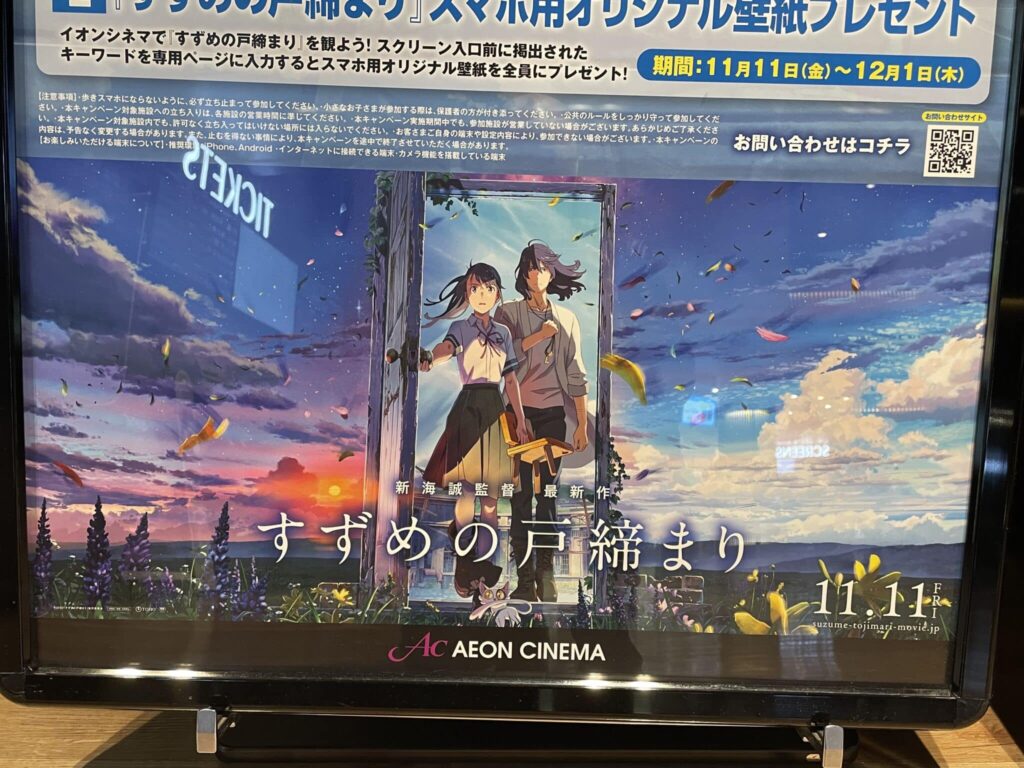[ad_1]
I can’t deny holding a small amount of skepticism tonight while taking my seat at a theater in Chofu, Tokyo, to see Suzume no Tojimari – the new film by popular anime auteur Shinkai Makoto. Shinkai is the director behind various modern classics of the anime medium, most notably the breakout global phenomenon Your Name (「君の名は。」). Like many the world over, I’m a major admirer of that film, and have strong memories associated with other Shinkai fare, like the highly bittersweet 2007 paeon to long-distance relationships, 5 Centimeters Per Second.
Sadly, I’ve also been left cold by Shinkai before – his themes (most often revolving around Japanese high schoolers experiencing long-distance and separation, whether physical or temporal) can be repetitive. When his movies connect emotionally, they tend to be home runs, but I’ve also found myself struggling to connect with about half of his catalog.
That was true even before Your Name became one of the most successful anime films of all time, and the indie-oriented Shinkai became seemingly locked into producing more easily accessible romance adventures. (Shinkai broke into long-form anime by writing, animating, and directing the short anime film Voices from a Distant Star by himself, creating the film entirely on his Power Mac G4; he even voiced one of the principal characters.) His previous film, 2019’s Weathering with You (「天気の子」), was thoroughly Shinkai. Breathtakingly beautiful, it featured the realistic-but-enhanced verisimilitude his movies are known for. It also fell far short of the emotional or structural success seen in Your Name, despite clearly trying to replicate that same atmosphere.
So, I went into Suzume no Tojimari ready for more of the same – a beautiful but passable film. What I got instead was one of the most exciting anime films I’ve seen in years.
Unlocking Suzume no Tojimari
Suzume no Tojimari (「すずめの戸締まり」, literally “Suzume’s Door-Locking”) begins amidst a picturesque port town in rural Miyazaki Prefecture, Kyushu. Immediately one gets the sense that we’re dealing with another of Shinkai’s many pet themes – that of the center vs. the periphery. Your Name also directly compared life in the metropolis of Tokyo against a countryside backdrop, and the use of local dialect reminds the viewer of that film’s protagonist, Mitsuha, and her life in a rural town.
High schooler Iwato Suzume (our titular protagonist) is riding her bike down a steep incline, the bay glittering in front of her, when she notices a long-haired, attractive man walking in her direction. She’s immediately taken with his looks. The man, Souta, stops her to ask if there might be any abandoned parts of town nearby – he’s looking after a certain door. When Suzume directs him towards the ruins of an older settlement in the mountains behind the town, she becomes involved in a quest to find similar doors throughout Japan; doors behind which lurch seismic, unholy dangers from a place humans are not meant to tread.
I went into this movie without watching a single full trailer, and avoided knowing too much about it beforehand. The initial Kyushu backdrop was enough to pique my interest (despite what looked like the standard Shinkai meet-cute, replete with mildly uncomfortable age difference). I’m a fan of Japanese films that deal in a meaningful way with areas outside of the great metropoles; that’s one of the reasons I enjoy Ghibli’s 1993 Shikoku-set Ocean Waves, for example. This movie goes further into this theme than any of Shinkai’s other movies, with its main viewpoint character being an inakamono (‘country bumpkin’) who proceed to take a journey across Japan by ferry, Vespa, car, and shinkansen.

Door to the Back Country
The countryside theming goes further than bucolic depictions or voice-acted dialects. In Zuzume no Tojimari, the source of danger emerges from doors left in abandoned, depopulated spaces; a deserted school building; a ghost theme park; a desolate town left to nature. The imagery rings true to anyone who’s lived in or spent any real time in the vast stretches of Japan beyond its biggest metros.
Japan’s rural areas are experiencing rapid depopulation; for seven decades, Japan’s population has centered more and more around major urban spaces. By 2015, 51.9% of the whole of the Japanese population was to be found in only the three most populous metropolitan regions. (Those surrounding Tokyo, Osaka, and Nagoya.) [1] Japan’s population as a whole is in a steep decline, which only furthers the issue of the hollowing out of rural spaces.
As rural populations shrink, their communities face a number of issues. According to scholar Bridget Love, “…remaining residents struggle with the logistics of decline: the care of elderly, the upkeep of vacant homes and land, encroaching forests, shrinking budgets for municipal snowplowing, and closing schools.” [2]

The Loss of a Cultural Home
Rural depopulation and the resulting breakdown of communities is one of the most pressing issues in Japan today. For long decades, the potential ramifications of population decline have weighed on the minds of many in this country; now, we’re beginning to face the reality of just how bad depopulation has become. In 2022, 65 new municipalities fell into the government’s official “depopulated category.” Amongst these, 36 of these are considered “wholly depopulated.” [3] Suzume no Tojimari touches on this clear-and-present crisis as few popular films have.
The issue of rural abandonment isn’t only one of statistics and breakdown of services. It’s an emotional loss, as well; whole communities disapear, with few remaining to remember them. People have the options of slowly watch their towns and villages hollow out, or leaving themselves. (A third option, pressing for revitalization, does exist – and has found success in some communities.) In Suzume no Tojimari, Shinkai portrays the detrius of memory in abandoned spaces as the a pathway to spiritual breakdown; doors left behind, unlocked, are a pathway for the otherworldly to enter and wreak chaos.
Shinkai’s Japan
Perhaps even more than Miyazaki, or Takahata, or Hosoda Mamoru (Summer Wars, Wolf Children; likely the most popular active theatrical anime director besides Shinkai) – all animation directors who focus on the minute details when presenting a lived-in, lifelike Japan – Shinkai seems to have desire to portray capital-J Japan. This is another film where shinto concepts play a major role, and which beautifies Japan and laments its very real rural breakdown.
Miyazaki and Takahata have presented deep portrayals of shintoist concepts and Japanese folklore (Spirited Away, Totoro, and especially Takahata’s Pom Poko all stand out), but they also critique Japanese society in a way Shinkai doesn’t seem to. Shinkai laments the tragedies that strike the country – depopulation, natural disasters, and cronic loniliness – without as obviously making political statements. It’s part of what sets him apart, but also makes his recent films feel, perhaps, a bit more “poppy.”
Reocurring Comparisons
Indeed, Shinkai and Hosoda are invariably compared to Miyazaki (and Ghibli as whole). Sometimes, this seems unfair – although their work does occupy a similar space as artistically rich and comparatively emotionally mature popular family fare, featuring Japanese societal vissimulitude. Shinkai, at least, did earn direct comparisons once, with his painfully derivative Children Who Chase Lost Voices. Where that movie went so far at at ape Miyazaki’s camera angles in an attempt to replicate that Ghibli feel, Suzume is thankfully all Shinkai.
Shinkai has stated that Miyazaki and Ghibli are some of his biggest influences, and a few moments still play tribute to Ghibli, – especially aurallly. The music stings when the massive “worms” from the world beyond first appear sound an awful lot like those used by composer Hisaishi Joe when tatarigami (cursed gods) made their appearance in Princess Mononoke. (The worms share much in common with the gelatinous maroon worms ingesting the cursed gods in that film, and even more with Mononoke’s undead Night Walker). The music nods go even farther, however, directly sampling a famous song used in an even more famous Ghibli film – and then having the characters comment on the song’s Ghibli connection.

Battle with the Beast
So, Suzume is distinctly Shinkai is styling and full of meaningful theming. But while compelling themes are good to have, but they alone do not make a movie enjoyable. Hosoda’s recent Belle had some intriguing themes regarding privacy and fame in the digital age, but UJ readers may recall that I didn’t really enjoy it all that much. What’s great about Suzume is that it has consistent themes set to a rollicking road-trip story with endearing characters, complete with some real thrills along the way.
The movie also simply looks better that Belle and many modern anime films. Unlike Hosoda’s recent offerings, it doesn’t rely on obvious cg models to populate crowd scenes. The animation is as vibrant and fluid as ever; a true testament to the staying power of 2D animation.
That animation is used to great effect in bringing Suzume‘s memorable cast of character to life. The primary pair, Suzume and Souta, may not quite light the world on fire like Your Name’s Mitsuha and Taki did, but they’re extremely likeable; you really want to see them succeed. Each of the rest of the vast cast features in only brief sections of the film based on location, but all are personable; more than your average stock anime characters. They also embody the localities they hail from, their lines of work so representative of different subsections of Japanese society. And, amazingly, the movie even has cute mascot characters that’re endearing without being obnoxious. That’s pretty much a miracle.

It’s a Lock
So, this movie pretty much has it all, as far as I’m concerned. Enjoyable pacing, real tension, a fantastic world of Shinto-derived fantasy that overlaps thematically with the issues facing modern Japan, and characters you care about. I haven’t even touched on much of the dramatic aspects of the plot, which are honestly gripping – often leaving me feeling fear for both the characters and Japan as a whole.
I’d actually hazard to say that it’s my favorite anime film I’ve seen in theaters since, well, Your Name in 2016. I’d be interested to watch Your Name and Suzume no Tojimari back to back; I have a feeling that Your Name is still all-around the better constructed film, but there’s aspects here I actually prefer. As far as pop anime goes, I’m not minding that Shinkai has left his indie days behind; not when we can get the occasional film as good as Suzume no Tojimari.

Sources:
[1] (2021). Statistical Handbook of Japan 2021. Statistics Bureau of Japan.
[2] Love, B. (2014). Sustainability at Dead-Ends: The Future of Hope in Rural Japan. RCC Perspectives, 3, 95–100.
[3] Koizumi, Hiroki. (February 7, 2022.) More than half of all municipalities in Japan defined as ‘depopulated’.
[ad_2]
Source link


